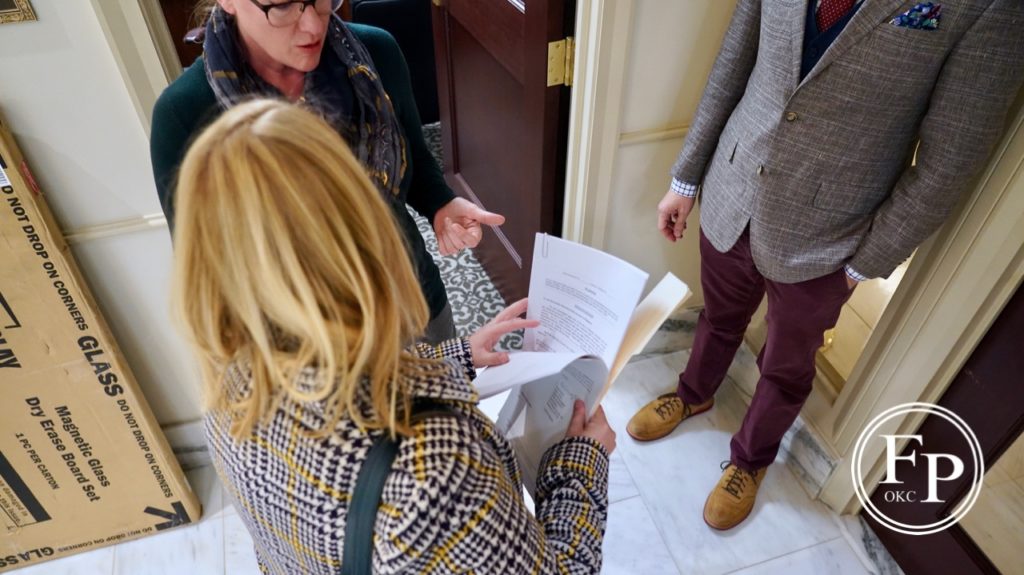Last Updated on October 29, 2019, 9:18 PM | Published: October 28, 2019
Gerrymandering or the process of elected officials drawing districts every ten years to benefit their own re-election would be ended in Oklahoma if a coalition has its way.
Some critics have referred to the legislature drawing district lines as “politicians picking voters instead of voters picking politicians.”
About People Not Politicians, Let’s Fix This, and The League of Women Voters are the three organizations that make up the core of the coalition.

Monday, that coalition filed an initiative petition with the Oklahoma Secretary of State to begin the process of putting a Constitutional amendment before the voters in the next upcoming election which was accepted and designated as State Question 804.
“We don’t want politicians fiddling with how their districts are picked,” said Andy Moore, founder, and executive director of Let’s Fix This, an organization designed to get ordinary people more involved in their government.
“By making politicians more accountable to voters, this proposal will force them to actually start focusing on finding solutions to the problems facing Oklahoma, like our struggling schools, our crumbling roads, and closing hospitals,” said Jan Largent in a prepared statement released after the petition was turned in.
She is the president of the League of Women Voters of Oklahoma.
“Oklahomans deserve to have fair and equal representation across the state, and partisan gerrymandering is keeping that from happening,” said Largent.
“This initiative will create more competitive elections, which will force politicians to be responsive to the needs of average citizens and start fixing many of the state’s real problems.”
Favoring the majority
Currently, the process of redistricting is carried out by legislators in a process that heavily favors the majority party in the Legislature.
For many years the Democratic Party was the majority and so drew lines to favor their party.
In 2010, the Republican Party became the majority party and so drew lines in 2011 to benefit its politicians.
The standard procedure under Democrats and Republicans – especially in the two large cities – has been for the majority party to draw lines that concentrate voters likely to vote for the majority party while fragmenting voters in the minority party across several districts to insure they are always outvoted.
After the news conference, Free Press asked Moore what some of the major challenges would be to getting the measure passed.
“We really want to help everyone understand that this is one of those things in the shadows, but super important, and has a huge impact on how democracy works in our state,” he said.
“The only people that are opposed to this are those that benefit from the current system,” said Moore. “So I am confident that with an independent commission that isn’t running for reelection, these districts will be able to draw them in a way that’s fair and free.”
Immediate push-back
But, Republican super-majority politicians are not going to let the process be easy.
In a matter of minutes after the petition was filed, Republican Senate President Pro Tempore Greg Treat from Oklahoma City issued a statement that invoked “President Obama and his Attorney General Eric Holder” (from a Presidential administration that ended three years ago) saying “This is a redistricting coup, not an attempt at fair maps.”
The heaviest gerrymandering in the state can be found in the Oklahoma City metro where the dense population represents the most pluralistic mix of cultures and political viewpoints in the state. (See the Oklahoma Senate District map for Oklahoma County at the bottom of this report.)
After the extreme statement about a “coup,” Let’s Fix This Executive Director Andy Moore responded back.
“Citizens using the state’s ballot initiative process is not a coup, but a sign that they have lost faith in our government to solve our state’s most pressing issues. It’s no surprise that our politicians are using the same old tactics to defend what is an indefensible process,” said Moore.
The proposal
The initiative petition filed today would take the redistricting process away from the closed doors of the Legislature that has exempted itself from open meetings and open records laws.
Instead, the proposal states:
Composition. The Commission shall consist of nine (9) Commissioners: three (3) Commissioners for each Group representing one of the two largest parties with ballot access at the time of the most recent General Election based on total registration, and three (3) Commissioners for the Group representing those that are unaffiliated with either of the state’s two largest political parties with ballot access at the time of the most recent General Election.
See the entire document embedded below.
Timeline
The next step is for the Secretary of State to review the petition turned in today and then set a date for the signature process to begin. Once the start date is set, supporters will have 90 days to gather 177,958 voter signatures to qualify for the November 2020 ballot.
If voters approve the measure in the November 2020 election, it will go into effect in time to determine the process of redistricting in 2021.
How redistricting works
Every ten years a census is taken in all 50 states to determine what the official population is of each state, who each person is, and to provide demographic information back to the states.
Then the next year states redraw districts according to the U.S. Constitution and federal law.
The next Census is in 2020, and the next redistricting effort in Oklahoma will begin in April 2021.
Some states have the legislature redraw district lines both for the legislature and for Congressional districts. That is the method Oklahoma uses at the present.
Other states have different groups draw lines for the legislature and then the Congressional districts.
And, some states have an independent commission that does the redistricting to keep politics and politicians out of the process.
That is the model this coalition is using in the initiative petition.
Ballotpedia has a good interactive map that shows which states use which approach.
Oklahoma_County_Detailed PNP-2019-Policy-FINAL-legal-formatted-1Founder, publisher, and editor of Oklahoma City Free Press. Brett continues to contribute reports and photography to this site as he runs the business.










